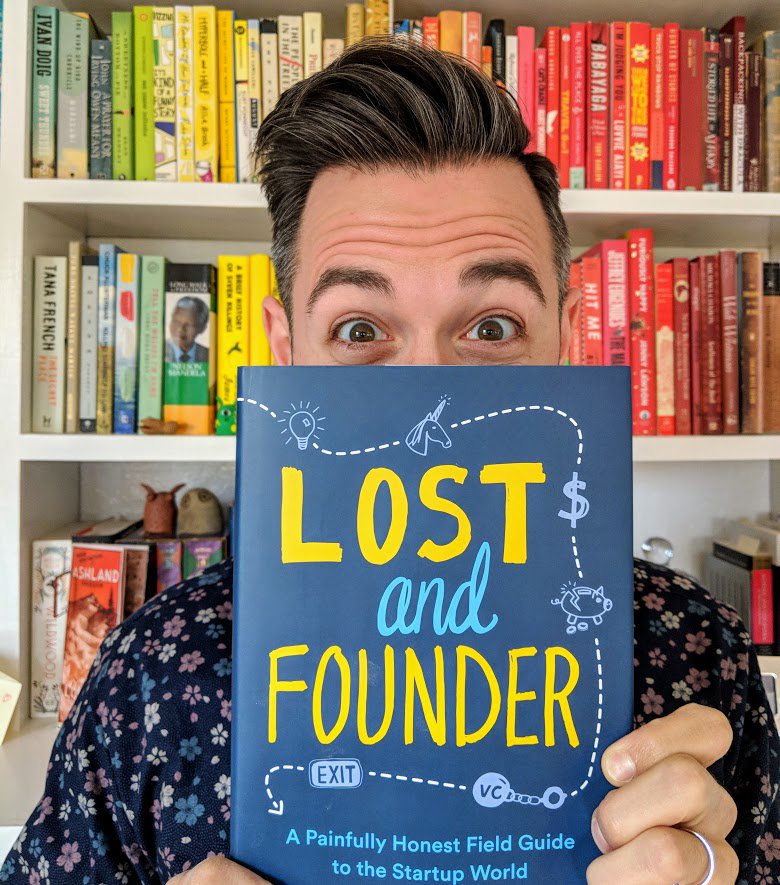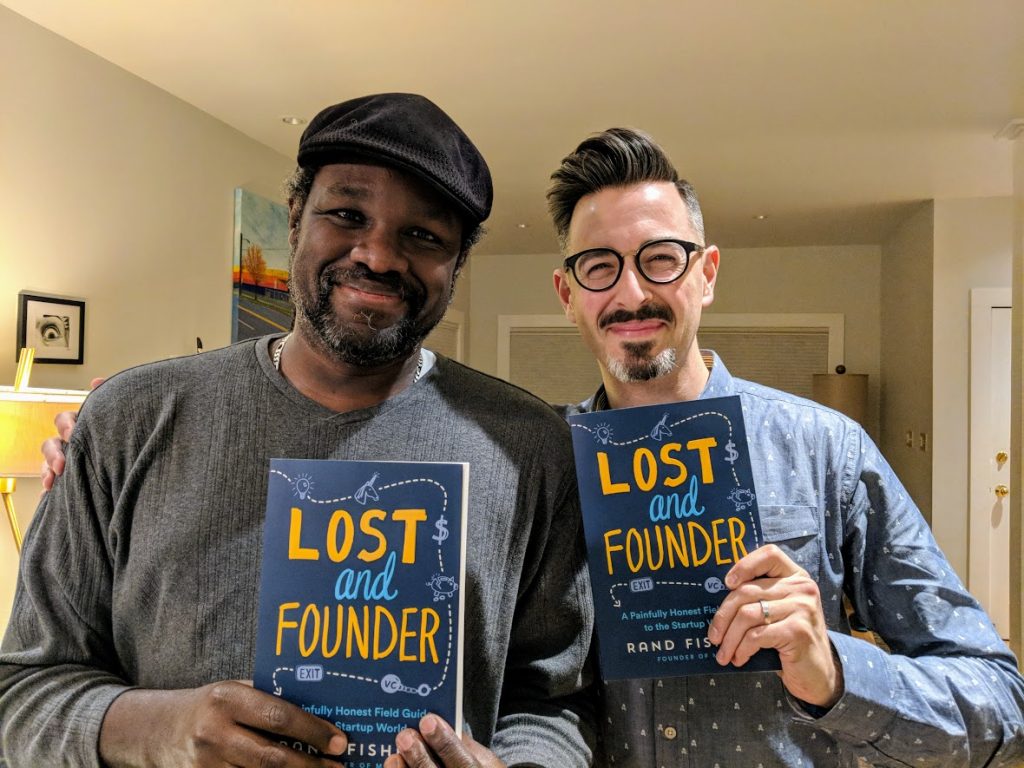For the last two years, I’ve been working on a book about what it’s like to build a tech startup and how Silicon Valley’s startup culture biases founders and companies to make a lot of poor decisions. That book, Lost and Founder, comes out in 14 days… I’m the usual mix of excitement and nervousness, elation and fear.
 The face of hesitant exuberance
The face of hesitant exuberance
In the process of pitching, writing, and editing Lost and Founder, I realized that it’s an unusual sort of business book. Most authors who write in the business world structure their work in the following way:
- A single, meme-worthy idea that can be easily explained in a sentence
- A title that encapsulates that idea
- Chapters that hammer home the idea and expand on its applications, tactics, and supporting research
The oft-repeated “key” to writing a successful (i.e. best-selling, well-amplified) business book is to make sure the book’s message and lesson can be easily boiled down and conveyed in a 10 minute TED talk, a short essay, or a hallway conversation between coworkers.
Well… Shit.
Lost and Founder doesn’t work that way at all.
When pitching Portfolio (my publisher), I explained how much I disliked that approach and how that tried-and-true formula was not the kind of book I wanted to write. That’s not to say I don’t absolutely appreciate how well it works as a marketing device. Easily conveyed information that’s oft-repeated, and easy to sum up removes friction from the amplification process. That leads to more people talking about a book and more people buying that book.
Some examples:
- Kim Scott’s excellent book, Radical Candor, shows people how to care personally and challenge directly at the same time to help people do their best work together. This graphic/tweet and this video do a great job of summing up those concepts.
- Simon Sinek’s Start with Why doubles down on his exceptionally popular and oft-memed talk about the importance of purpose in business, and how it drives teams to perform better and customers to build stronger bonds with products and brands. This short video and the top of this summary do a great job of capturing its content.
- Gary Vaynerchuck’s Jab, Jab, Jab, Right Hook explains why brands should be using social media and content that “jabs” (i.e. engages people and triggers an emotional response) with greater frequency and before they use “right hooks” (that promote and sell). This video and these takeaways capture the content well.
Not every business book works this way, of course.
When pitching Lost and Founder, I frequently referenced Ben Horowitz’s The Hard Thing About Hard Things. It’s a book that’s similar to my own, in that it relies on a wide range of stories to teach a wide range of lessons and expose readers to the experiences they may confront should they enter the tech/business world. Summing it up is hard. Amplifying it in a sentence is, too. Different people will resonate with different lessons, and plenty of folks may even disagree about the relevance of various stories, what they teach, and how it might apply to their own experiences. It’s an excellent book to learn from, but a hard book to meme or to sell in a sentence.
Derek Sivers’ Anything You Want works similarly — it’s essentially a collection of essays (whose whole is more than the sum of its parts thanks to a connected narrative about Sivers’ company) that each have their own takeaways. The subtitle “40 lessons for a new kind of entrepreneur” is the closest you can get to a one sentence description.
The best I can do to “sum up” Lost and Founder is probably this:
Silicon Valley startup culture biases companies to make lots of dumb decisions. This book will help you avoid those by transparently sharing stories, data, and better alternatives.
There’s 18 chapters in the book, each taking a commonly-held bit of startup wisdom and exposing the reality of who that works for and what happens when it doesn’t. My goal is to dismantle (or at least, add crucial context to) Silicon Valley’s holy grails like “don’t wait to polish your product; launch an MVP first,” “build a product business, not a services business,” and “go for the long ball; don’t sell out early.”
That makes this a weird book. But I just didn’t feel passionate about writing something with a singular sort of focus.
 My friend Marcus (who works as an engineer at Amazon), while crashing at our place and reading the first chapter after dinner one evening told me, “you make this startup stuff pretty accessible.” That made me happy.
My friend Marcus (who works as an engineer at Amazon), while crashing at our place and reading the first chapter after dinner one evening told me, “you make this startup stuff pretty accessible.” That made me happy.
The question will be whether this type of book can still resonate and spread. By using this “hard-to-soundbite” structure, I’ve added friction to the marketing process. I have to hope that the content is compelling enough and the problems it solves painful enough that, in spite of that friction, it works.
Since the book isn’t out for another two weeks, the only folks who’ve read it are those who received preview/media copies. So far, they’ve had really nice things to say…
Just finished reading my advanced copy of @randfish new book “Lost and Founder”. This is a MUST read book for every tech entrepreneur. Truly amazing stories and insight. Rand, I got the book on Saturday morning and could not put it down. #AmazingWork
— Sean Jackson (@seanthinks) March 18, 2018
Finished reading that the other day. It’s everything the Hard Thing about Hard Things was supposed to be, but wasn’t.
— MyCool King (@iPullRank) March 19, 2018
A MUST READ for any entrepreneur:
Entertainingly raw, witty, no fluff startup insights that can save you YEARS of stumbling!
Lost and Founder by @randfishhttps://t.co/VdH1GvHHbn
Couldn’t put it down. SO incredibly proud of you Rand! ❤ CONGRATS!!! pic.twitter.com/DaK9VSyMM9
— Britney Muller (@BritneyMuller) April 1, 2018
Reading through an early copy of @randfish‘s new book, Lost and Founder, and it’s packed with so many gems that aren’t talked about enough.
“It’s dangerous to go it alone. You want people around you.” Basically the entire idea behind @IndieHackers! pic.twitter.com/0xB2Yuno2T
— Courtland Allen (@csallen) March 22, 2018
But part of my impostor syndrome is that I rationalize those away thinking “well, they know me or maybe like me personally, so…” That’s dumb. If the people who know me and like me like the book, I should take it as a huge compliment. I think I’m just holding my breath on this. Anyone who knows me knows I’ve rarely ever put something out in the world that I’m proud of — I’ve always been critical of the products I’ve worked on, the blog posts I’ve written, the videos I’ve done. I always think I can do better.
That’s why Lost and Founder scares me. It’s the thing I’m most proud of that I’ve launched in the last five years (maybe a close tie with KW Explorer)… What if that’s not good enough? At least there’s only a few more days to wait.
p.s. If you’d like to grab a copy of this weird business book, it’s available on Amazon in the US, Amazon in the UK, Powells, IndieBound, and most major+indie bookstores. And please, leave a review or tell me what you thought of it. I’m dying to know 🙂
